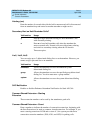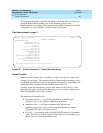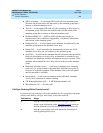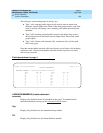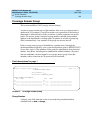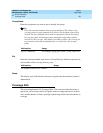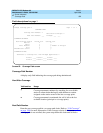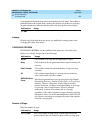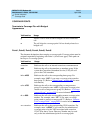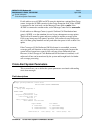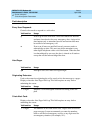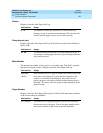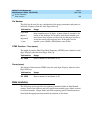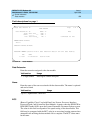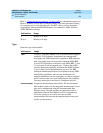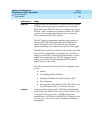
DEFINITY ECS Release 8.2
Administrator’s Guide
555-233-506
Issue 1
April 2000
Screen reference
554Coverage Path
17
COVERAGE POINTS
Terminate to Coverage Pts. with Bridged
Appearances
Point1, Point2, Point3, Point4, Point5, Point6
The alternate destinations that comprise a coverage path. Coverage points must be
assigned sequentially beginning with Point 1 (do not leave gaps). Each path can
have up to six coverage points.
Valid entries Usage
y
Allows a call to alert as both a bridged call and a redirected
call.
n
The call skips the coverage point if it has already alerted as a
bridged call.
Valid entries Usage
extension Redirects the call to an internal extension or announcement
attd
Redirects the call to the attendant or attendant group. If the
system has Centralized Attendant Service (CAS), the call
goes to the CAS attendant.
h1 to h255 Redirects the call to the corresponding hunt-group. For
example, enter “
h32” if you want a coverage point routed to
hunt group 32. (Refer to ‘‘
Hunt Group’’ on page 696 for more
information.)
c1 to c750 Redirects the call to the corresponding coverage answer
group. For example, enter “
c20” if you want a coverage point
routed to call coverage answer group 20. (Refer to ‘‘
Coverage
Answer Group’’ on page 550 for more information.)
r1 to r999 Redirects the call to the corresponding remote coverage point
number. For example, enter “
r27” if you want a coverage
point routed to remote coverage point 27. (Refer to ‘‘
Remote
Call Coverage Table’’ on page 863 for more information.)
v + extension Redirects the call to the corresponding VDN extension. For
example, enter “
v12345” if you want the last administered
coverage point to be the VDN associated with extension
12345. Note that a Vector Directory Number may be used
only as the last administered point in a coverage path.



